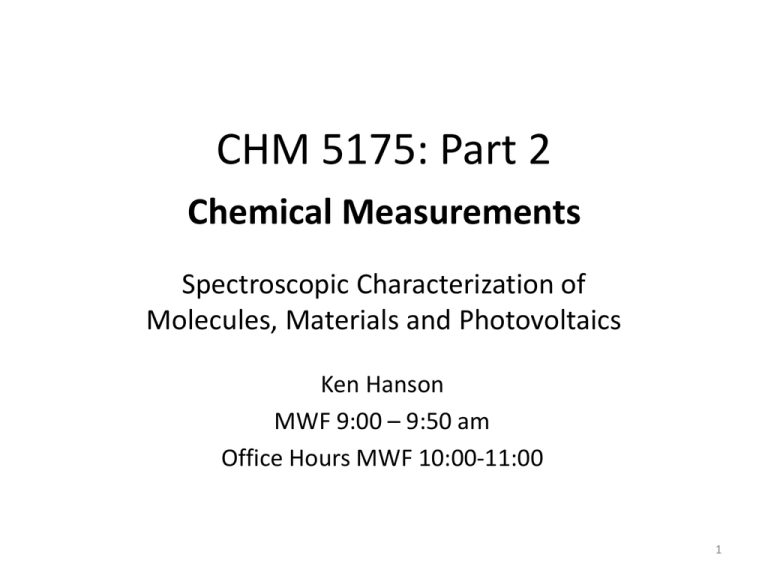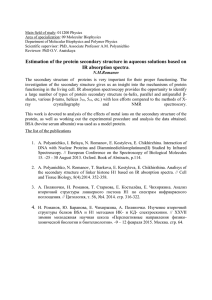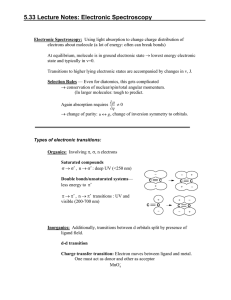Syllabus Day
advertisement

CHM 5175: Part 2 Chemical Measurements Spectroscopic Characterization of Molecules, Materials and Photovoltaics Ken Hanson MWF 9:00 – 9:50 am Office Hours MWF 10:00-11:00 1 Why are we here? 1) To increase scientific literacy 2) To prepare you for your future 3) A means of evaluating you 2 1) To increase scientific literacy Public (Electorate) Educators Researchers You Are Here 3 2) To prepare you for your future “It’s tough to make predictions, especially about the future” -Yogi Berra Adult Stem Cells (2006) Human Genome Solved (2003) Mars Rover (2004) Isolated Graphene (2004) 4 2) To prepare you for your future “It’s tough to make predictions, especially about the future” -Yogi Berra Wikipedia (2001) (2004) Kyocera 6035 (2001) Google Maps (2005) (2005) 5 2) To prepare you for your future “It’s tough to make predictions, especially about the future” -Yogi Berra Classroom Content a) Factual Information b) Procedural Information c) Conceptual Information Anderson and Krathwohl A Taxonomy For Learning, Teaching and Assessing. New York, 2001. 6 2a) Factual Information - Terminology - Specific details - Example: Memorizing the periodic table 7 2a) Factual Information Good for: Trivia Learning scientific language Quicker processing of information Limitations: Problem specific Discipline specific You can be replaced by a phone! 8 2b) Procedural Information - Directly applied to a task - Subject‐specific skills/techniques - Executing an algorithms 9 2b) Procedural Information • Good for: – Day to day tasks (thinking is exhausting) – Running specific instruments – Performing tasks quickly and efficiently • Limitations – – – – Start from scratch when the medium changes Compartmentalization Troubleshooting You can be replaced by a macro and/or robot 10 2b) Procedural Information Last Serny, Flingledobe and Pribin were in the Berdlink treppering gloopy caples and cleaming burly greps. Suddenly a ditty strezzle boofed into Flingledobe’s tresk. Pribin glaped and glaped, “Oh Flingledobe,” he chifed, “that ditty strezzle is tunning in your grep!” 1. When did Flingledobe and Pribin trepper? 2. What kind of caples did Flingledobe and Pribin trepper? 3. What did the ditty strezzle do to Flingledobe’s tresk? 4. What was Pribin’s reaction? 5. Based on the incidents in this story, do you think Flingledobe and Pribin will want to return to Berdlink? Why or why not? 6. What do you think will happen next? Lavoie, R.D. Understanding Learning Disabilities - How Difficult Can It Be? PBS Video. Alexandria, VA. 1989 11 2c) Conceptual Information - Composed of relationships - Network of knowledge - Representations Rotating Chair and Bicycle Wheel Intersystem Crossing 12 2c) Conceptual Information • Advantages: – – – – – – Problem solving Situation independent Creativity (tying concepts together) Understand the limits of procedures Testable hypothesis Can use multiple procedures to find the “answer” • Drawbacks: – Thoughtful, reflective learning. – Harder to teach and grade (Example: double rxn rate). 13 CHM 5175: Part 2 Spectroscopic Characterization of Molecules, Materials and Photovoltaics a) Factual Information - Names of techniques - Names of phenomena b) Procedural Information - Steps to characterization c) Conceptual Information - Instrument architectures - Photophysical phenomena - Measurement limitations 14 Course Content 1) Absorption 2) Fluorescence Source Detector Source hn Detector hn Sample 3) Transient Absorption Sample Source Source hn hn Detector 4) Device Measurements Multimeter Source hn Sample Sample 15 Course Content 1. Introduction to Molecular Photophysics - Photophysical transitions - Jablonski diagrams 2. Absorption Spectroscopy - Architecture, components - Circular dichroism, IR techniques 3. Fluorescence Spectroscopy - Steady-state - Time-resolved emission - Quantum yield 4. Transient Absorption Spectroscopy -slow, fast, ultrafast 5. Solar Cell Characterization - I-V curve, IPCE, efficiency, EIS 16 Course Goals • Turn you all into spectroscopists? • Intro to spectroscopy – Learn about the techniques that are available – Learn some of the language • Fill your toolbox Reality How we teach chemistry Analytical Organic Physical Inorganic Biochem Analytical Physical Organic InorganicBiochem Your answer is here You are here 17 How I teach • Powerpoint slides • Lots of Imagery • Limited equations • Microscopic things in a macroscopic way • Examples related to my research • I will go to fast Optional Texts: Principles of Instrumental Analysis (Skoog, Holler and Nieman) Principles of Fluorescence Spectroscopy (Lakowicz) 18 Why are we here? 1) To increase scientific literacy 2) To prepare you for your future 3) A means of evaluating you 19 3) A means of Evaluating You Grading: 50% Homework (2 assignments) 50% Final Examination Grades will be assigned based on a standard scale (A/A- = 10090%; B± = 89-80%; C±=79-70%; etc...), normalized as appropriate based on course content and instructor expectations. 20 Why are we here? 1) To increase scientific literacy 2) To prepare you for your future 3) A means of evaluating you 4) Recruiting students 21 Any questions? 22 Course Content 1. Introduction to Molecular Photophysics - Photophysical transitions - Jablonski diagrams 2. Absorption Spectroscopy - Architecture, components - Circular dichroism, IR techniques 3. Fluorescence Spectroscopy - Steady-state - Time-resolved emission - Quantum yield 4. Transient Absorption Spectroscopy -slow, fast, ultrafast 5. Solar Cell Characterization - I-V curve, IPCE, efficiency, EIS 23











